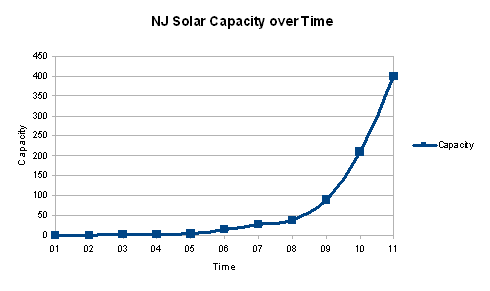Strike 1 – Solar Power
When the NJ Clean Energy Program started in 2001, there were six (6) solar energy systems and a nameplate capacity of nine (9) kilowatts. By December 31, 2010 there were over 7000 systems with a combined capacity close to 300 megawatts, MW, of solar electric generating capacity. In the first six months of 2011, another 100 MW was added, bringing the total to 400 MW by June 30, 2011. By these metrics, the NJ Clean Energy Program has been successful.
We at Popular Logistics congratulate the Governors of New Jersey, the people at the Board of Public Utilities and Clean Energy Program, the citizens, taxpayers, groups like the Sierra Club, Clean Ocean Action, NJ Public Interest Research Group, Inc., and entrepreneurs for installing 400 MW of solar capacity in less than 11 years.
We also congratulate the people pushing for wind power, wave power, tidal energy, goethermal, and efficiency.
We are confident that the goal of 22.5% clean energy by 2021 will be met. We also think the Renewable Energy Portfolio Standard should be expanded to 30% clean, renewable, sustainable energy by 2020 as described on the RPS Rule Revisions document of January, 2011, here, and 100% by 2035. By “Clean, renewable, sustainable energy” we mean energy from natural geo-ecological systems such wind, solar, and geothermal and natural biological systems such as sewage, manure, non-food crops.
We would like to see a 50 KW PV solar array on every public school, a 500 KW solar array on each of the 19 Community Colleges, and a 1.5 MW solar array on each of the public colleges and universities.
Strike 2 – Closing Oyster Creek
The New Jersey Department of Environmental Protection, NJDEP, and Exelon Generation Company, LLC, Exelon, entered an Administrative Consent Order (ACO) on December 9, 2010, (Press Release 1, Press Release 2) which requires Exelon to
- Terminate operations at the Oyster Creek Generating Station on or before December 31, 2019, and,
- Maintain the Oyster Creek Generating Station throughout its period of operation “in a maner that ensures operation is fully in accord with its permits and consistent with the operating license issued by the United States Nuclear Regulatory Commission (NRC).”
Strike 3 – No New Coal, including Coal with Carbon Sequestration
On July 26, 2011, at the Board of Public Utilities (BPU) hearing on the New Jersey Energy Master Plan (EMP) hearing, Lee Solomon, the President of the BPU, said, regarding the PurGen coal with sequestration plant that is being planned for Linden, “That project is not going forward as a coal carbon sequestration plant. The Governor has said ‘no’ to any coal…I say that publicly, and on the record, and so did the Governor.”
Purgen is a plan to build a 400 to 562.5 MW coal with sequestration plant at a cost of $9 Billion. More details at the League of Women Voters and The NJ Sierra Club. I first began covering it here at Popular Logistics in 2009.
It is important to note that the Governor’s decision appears to have been based on neoclassical economics – at $18 billion per gigawatt Purgen is expensive, more expensive than the alternatives. In a telephone conversation with me on Sept. 7, 2011, Jeff Tittel, of the NJ Sierra Club said “there is a rule prohibiting pumping toxic industrial wastes along the ocean floor. But this rule does not currently describe carbon dioxide, from coal plants, as a ‘toxic industrial waste.’ Therefore, while Gov. Christie is against this plant today, it is not ‘dead’ yet.”
But … One “Home Run” doesn’t win the game.
 As baseball great and Jersey resident Yogi Berra has said, “It ain’t over till it’s over.” Meeting the goal of generating 22.5% of our electricity in New Jersey by clean systems by 2021 means we still generate 77.5% by not-necessarily-clean systems. And that doesn’t include transportation and heating systems.
As baseball great and Jersey resident Yogi Berra has said, “It ain’t over till it’s over.” Meeting the goal of generating 22.5% of our electricity in New Jersey by clean systems by 2021 means we still generate 77.5% by not-necessarily-clean systems. And that doesn’t include transportation and heating systems.
Sustainable Jersey
Gov Christie needs to follow thru on his plan to protect Barnegat Bay, (here and here) and, along with other governors, mayors, and the President, needs to develop and follow thru on other plans to shift the paradigm from fuel and waste based systems to clean, renewable sustainable energy systems.
As noted above, we would like to see a 50 KW PV solar array on every public school, a 500 KW solar array on each of the 19 Community Colleges, and a 1.5 MW solar array on each of the public colleges and universities. We would also like to see solar arrays on municipal parking lots, train stations, and on the roofs of “big box” stores, shopping malls, and factories, warehouses, and, of course, homes all across the United States, not just in New Jersey.
And, to make a “bold” prediction, we expect that we will. In the summer of 2005 the installed cost of PV Solar was $7.75 to $8.50 per watt. In 2009 it was $6.50 per watt. By 2014 the installed cost of solar will probably be at or below $4.00 per watt of nameplate capacity, or $4.0 billion per gigawatt. At the same time the costs of coal with sequestration, assuming current designs work, will approach $20.00 per watt ($20 Billion per gigawatt) and that excludes the costs of ecosystem services lost to strip mining and the costs of cleanup of the coal ash. Similarly, the costs of nuclear will approach $12.0 Billion per gigawatt or more, excluding the costs of fuel and security, currently borne by the government, that is the taxpayers, and the costs of a disaster along the lines of Fukushima, or a problem along the lines of Fort Calhoun.
In the “State of the Union Address,” January, 2011 (Popular Logistics / White House.Gov) President Obama challenged us to “80% clean electricity by 2035.” That’s a good goal, but we could achieve 100% by 2035.
This would be good for the environment, good for the economy, and it would lower health care costs. It would not be good for people with interests in coal, oil, methane, or nuclear power.
